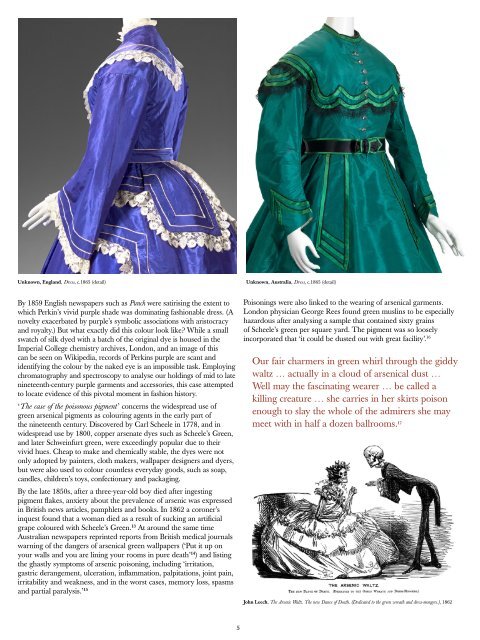FASHION-DETECTIVE
FASHION-DETECTIVE
FASHION-DETECTIVE
Create successful ePaper yourself
Turn your PDF publications into a flip-book with our unique Google optimized e-Paper software.
Unknown, England, Dress, c.1865 (detail)<br />
Unknown, Australia, Dress, c.1865 (detail)<br />
By 1859 English newspapers such as Punch were satirising the extent to<br />
which Perkin’s vivid purple shade was dominating fashionable dress. (A<br />
novelty exacerbated by purple’s symbolic associations with aristocracy<br />
and royalty.) But what exactly did this colour look like? While a small<br />
swatch of silk dyed with a batch of the original dye is housed in the<br />
Imperial College chemistry archives, London, and an image of this<br />
can be seen on Wikipedia, records of Perkins purple are scant and<br />
identifying the colour by the naked eye is an impossible task. Employing<br />
chromatography and spectroscopy to analyse our holdings of mid to late<br />
nineteenth-century purple garments and accessories, this case attempted<br />
to locate evidence of this pivotal moment in fashion history.<br />
‘The case of the poisonous pigment ’ concerns the widespread use of<br />
green arsenical pigments as colouring agents in the early part of<br />
the nineteenth century. Discovered by Carl Scheele in 1778, and in<br />
widespread use by 1800, copper arsenate dyes such as Scheele’s Green,<br />
and later Schweinfurt green, were exceedingly popular due to their<br />
vivid hues. Cheap to make and chemically stable, the dyes were not<br />
only adopted by painters, cloth makers, wallpaper designers and dyers,<br />
but were also used to colour countless everyday goods, such as soap,<br />
candles, children’s toys, confectionary and packaging.<br />
By the late 1850s, after a three-year-old boy died after ingesting<br />
pigment flakes, anxiety about the prevalence of arsenic was expressed<br />
in British news articles, pamphlets and books. In 1862 a coroner’s<br />
inquest found that a woman died as a result of sucking an artificial<br />
grape coloured with Scheele’s Green. 13 At around the same time<br />
Australian newspapers reprinted reports from British medical journals<br />
warning of the dangers of arsenical green wallpapers (‘Put it up on<br />
your walls and you are lining your rooms in pure death’ 14 ) and listing<br />
the ghastly symptoms of arsenic poisoning, including ‘irritation,<br />
gastric derangement, ulceration, inflammation, palpitations, joint pain,<br />
irritability and weakness, and in the worst cases, memory loss, spasms<br />
and partial paralysis.’ 15<br />
Poisonings were also linked to the wearing of arsenical garments.<br />
London physician George Rees found green muslins to be especially<br />
hazardous after analysing a sample that contained sixty grains<br />
of Scheele’s green per square yard. The pigment was so loosely<br />
incorporated that ‘it could be dusted out with great facility’. 16<br />
Our fair charmers in green whirl through the giddy<br />
waltz … actually in a cloud of arsenical dust …<br />
Well may the fascinating wearer … be called a<br />
killing creature … she carries in her skirts poison<br />
enough to slay the whole of the admirers she may<br />
meet with in half a dozen ballrooms. 17<br />
John Leech, The Arsenic Waltz. The new Dance of Death. (Dedicated to the green wreath and dress-mongers.), 1862<br />
5


